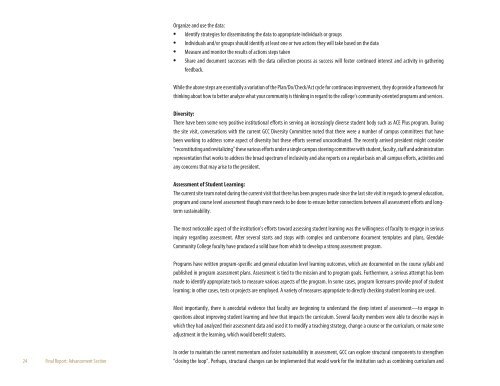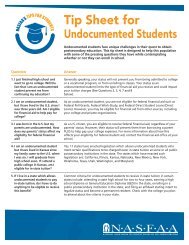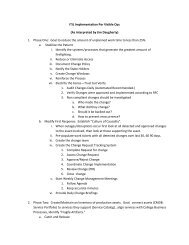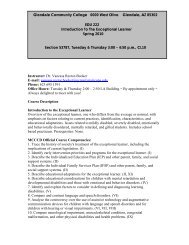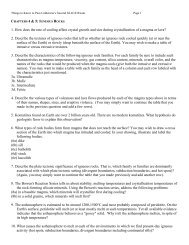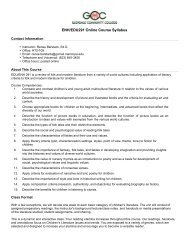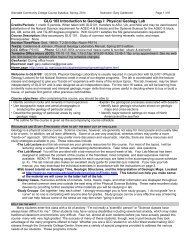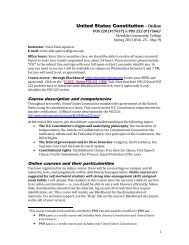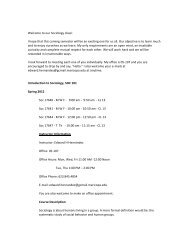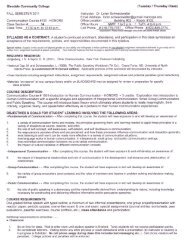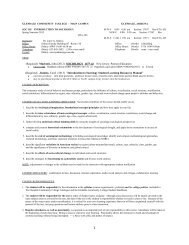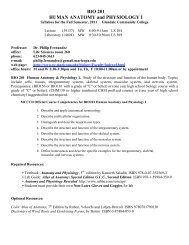final report from HLC - Glendale Community College
final report from HLC - Glendale Community College
final report from HLC - Glendale Community College
You also want an ePaper? Increase the reach of your titles
YUMPU automatically turns print PDFs into web optimized ePapers that Google loves.
Organize and use the data:• Identify strategies for disseminating the data to appropriate individuals or groups• Individuals and/or groups should identify at least one or two actions they will take based on the data• Measure and monitor the results of actions steps taken• Share and document successes with the data collection process as success will foster continued interest and activity in gatheringfeedback.While the above steps are essentially a variation of the Plan/Do/Check/Act cycle for continuous improvement, they do provide a framework forthinking about how to better analyze what your community is thinking in regard to the college’s community-oriented programs and services.Diversity:There have been some very positive institutional efforts in serving an increasingly diverse student body such as ACE Plus program. Duringthe site visit, conversations with the current GCC Diversity Committee noted that there were a number of campus committees that havebeen working to address some aspect of diversity but these efforts seemed uncoordinated. The recently arrived president might consider“reconstituting and revitalizing” these various efforts under a single campus steering committee with student, faculty, staff and administrationrepresentation that works to address the broad spectrum of inclusivity and also <strong>report</strong>s on a regular basis on all campus efforts, activities andany concerns that may arise to the president.Assessment of Student Learning:The current site team noted during the current visit that there has been progress made since the last site visit in regards to general education,program and course level assessment though more needs to be done to ensure better connections between all assessment efforts and longtermsustainability.The most noticeable aspect of the institution’s efforts toward assessing student learning was the willingness of faculty to engage in seriousinquiry regarding assessment. After several starts and stops with complex and cumbersome document templates and plans, <strong>Glendale</strong><strong>Community</strong> <strong>College</strong> faculty have produced a solid base <strong>from</strong> which to develop a strong assessment program.Programs have written program-specific and general education level learning outcomes, which are documented on the course syllabi andpublished in program assessment plans. Assessment is tied to the mission and to program goals. Furthermore, a serious attempt has beenmade to identify appropriate tools to measure various aspects of the program. In some cases, program licensures provide proof of studentlearning; in other cases, tests or projects are employed. A variety of measures appropriate to directly checking student learning are used.Most importantly, there is anecdotal evidence that faculty are beginning to understand the deep intent of assessment—to engage inquestions about improving student learning and how that impacts the curriculum. Several faculty members were able to describe ways inwhich they had analyzed their assessment data and used it to modify a teaching strategy, change a course or the curriculum, or make someadjustment in the learning, which would benefit students.24 Final Report: Advancement SectionIn order to maintain the current momentum and foster sustainability in assessment, GCC can explore structural components to strengthen“closing the loop”. Perhaps, structural changes can be implemented that would work for the institution such as combining curriculum and


